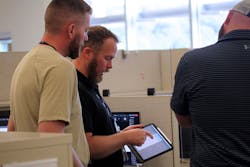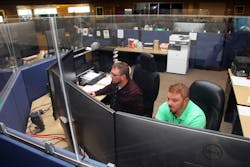What if front-line field personnel in the midst of storm recovery could summon real-time operations data in the palm of their hand, gaining the same awareness of outage isolation and switching information as the control room? This is not a hypothetical. Increasing demands on power grids require far more nimble responsiveness, problem pinpointing, and accurate forecasting than ever before to maintain reliability. This creates everything-all-at-once scenarios with higher frequencies.
The Front-line Challenge
The complexity of today’s grid requires real-time awareness on a greater granular level than ever before. That means matching and scheduling power for customers against clean but more intermittent generation from wind and solar power, and adjusting to the impacts of EVs charging, smart thermostats, and other devices on the grid. Grid operators are on the front lines of the energy transition and climate change.
For FirstEnergy, its challenges were tenfold, literally. The company wanted to migrate legacy grid management systems for 10 utility operating companies serving 6.1 million customers in six states to adopt the Oracle Utilities Network Management System, Oracle’s Advanced Distribution Management System (ADMS) offering.
This four-year mega project, known internally at FirstEnergy as “aDAPT” (Distribution Applications Powering Tomorrow), went live in August 2022, bringing 269,000 miles of distribution lines under a singular system to manage outage restoration, advanced applications (Distribution Automation (DA) and Volt/Var Optimization (VVO) – Ohio operating companies only) and more. To our knowledge, this project comprising a single ADMS across multiple service territories is the most significant ADMS adoption by a large utility corporation in terms of cost, schedule, and functionality.
“Simply put, we needed our system to let us easily see and predict how power is moving on an increasingly complicated and layered grid, while also ensuring everyone across service territories are operating from the same place in terms of process, software, and shared purpose,” said Ted Allan, Director, ADMS/GIS Project, FirstEnergy.
“We also wanted to implement a new fully integrated system that would be foundational for additional smart grid investment.”
The forerunner for the new system deployed by FirstEnergy was the original ADMS developed in 2007 by Oracle. The architecture of ADMS has the capability to expand to handle additional demands, from the proliferation of a wide variety of DERs — such as rooftop solar, EVs, and battery storage — to changing weather patterns with extreme weather events. These platforms aid in automated outage response and help optimize performance of utility distribution grids utilizing a common model and operator user interface.
Streamlining and Efficiencies
The FirstEnergy project shows how a system can be built to provide real-time awareness across multiple streams of data, from measuring customer load and detecting outages, to forecasting weather and power price effects on demand. This, combined with predictive modeling, allows operators to be deliberately responsive and proactive instead of only being reactive. The resulting ADMS functions on a single software platform, serving as both a digital twin and a nerve center that can unify complex operations, centralize decision-making, and bring consistency across the operating companies.
- On the ground, line workers can clearly see what’s happening with Oracle’s Operational Mobile Application (OMA), which enables them to update outages directly from their mobile device.
- In district offices and other remote locations, FirstEnergy staff can easily connect to a browser-based version of the ADMS – called Flex Operations – to help manage outages, crews, and switching.
Heightened Awareness
A key objective was to give control room operators and field workers the same situational awareness.
The Oracle Utilities NMS Flex Operations (FlexOps) application extends outage management and crew dispatch capabilities beyond the control room, enabling hundreds of additional users to quickly and securely log on to help manage outage restoration activities. FlexOps includes outage and crews lists, and an interactive network viewer that displays conductor highlights, phases, text annotations, map backdrops, and other real-time network information similar to the core ADMS.
Field crews can receive outage restoration, damage response, and hazard assessment tasks on their mobile devices, and then can provide updates directly, without waiting to relay information back to the control room. The new system also lets operators ping AMI meters to quickly see if any downstream nested outages remain, avoiding return trips by restoration crews and, hopefully, increasing customer satisfaction.
So the traditional methods of managing outage dispatch and transcribing outage updates from within the control room are evolving. Control room staff are now supported by remote users and mobile-enabled crews, removing workflow bottlenecks and communication bottlenecks. This shortens the outage impact while helping the utilities keep utility customers informed and safe.
The new ADMS system was recently put to the test with a series of severe thunderstorms in late March and early April causing outages for customers in Ohio, Pennsylvania, and neighboring parts of FirstEnergy service territories. After the first wave of storms, Oracle and FirstEnergy undertook an after-action review to see how to improve the pace of outages restoration, and then enhanced some of the configurations for system monitoring alarms as well as the mobile application. As a result, when the second wave of storms rolled in, the Oracle ADMS system showed processing improvements to allow personnel to the east of the affected areas to assist in their colleagues’ territories to optimize the dispatch of mutual aid crews for outage restorations.
“The enhancements put more visibility on the outages so we could ensure efficient response,” Allan said. “This system is truly flexible in adapting to our needs and adjusting on the fly with improvements.”
Managing DER Behavior with Machine Learning
Machine learning helps utilities better monitor, control and optimize behind-the-meter devices, including taking control during peak demand periods to keep the grid stabilized and conserve energy.
Automated voltage regulators and line capacitor banks were installed on select circuits within FirstEnergy’s Ohio operating companies to help ensure safe, constant voltage levels along power lines on extremely cold or hot days that create high demand for electricity. In addition to preventing voltage issues for customers, the NMS could potentially help provide energy savings by evenly distributing electricity, through control of these devices via the NMS’s VVO application, to allow all customers served by a single power line to receive the same flow of safe, reliable power.
These operational enhancements, in turn, help utilities provide better options for customers. For instance, a utility’s increased visibility into real-time hourly and peak load data can enable the marketplace to develop customer rate-choice programs and utilities can work with customers to more easily add new, grid-integrated devices.
Mixing Old and New
All of these enhancements need to seamlessly integrate with the utilities’ existing system architecture.
When FirstEnergy embarked on the optimal way to deploy an ADMS, it wanted to leverage as many existing systems investments as possible, including the existing backbone of Supervisory Control and Data Acquisition (SCADA). Instead, it sought an ADMS that would work across its operations and draw on multiple existing strengths.
There also was no need to reinvent the wheel or strand assets. Instead, Oracle Utilities Live Energy Connect provided a scalable, technology-agnostic integration with an OT-centric middleware platform that supports all major protocols for utilities’ existing SCADA systems. The overall project also ensures cybersecurity for integrated technologies under one NERC-CIP compliant architecture with IP-based network compatibility.
“We developed a much smarter grid and brought our operating companies onto the same page, virtually onto the same screen,” Allan added. “The project helped us compose an expanded architecture that maintains key assets, such as SCADA, and added tools for a new system that is greater than the sum of its parts. This creates an orchestration of grid operations that is responsive, efficient, optimized and secure.”
The project retained the existing strengths and built new functions to handle the various new dynamics of the modern grid. It also provides efficiencies by using a single platform to replace multiple systems and procedures.
“Together, we were able to unravel the Gordian knot from integrating a series of acquisitions, each bringing varying systems and significant unnecessary complexities. We created a new universal framework that better serves customers of multiple utilities across a vast swath of the country,” said Brad Harkavy, vice president of product, Oracle Energy and Water. “This shared system literally brings calm to the storm, giving crews and operators from different service areas the ability to jump in and seamlessly and safely support each other when every minute counts.”
FirstEnergy reports that its adoption of this integrated ADMS platform has resulted in DER visibility, improved reliability and customer service, and reduced costs across operations. Importantly, this was not an off-the-shelf solution. Oracle and FirstEnergy collaborated through the course of the project on enhancements to create new capabilities to the ADMS-licensed product Oracle provides for other utilities.
“This ADMS platform provides better control over surging DERs and grid devices, to more accurate confirmation of timely restoration efforts, the grid can evolve apace with, and even ahead of, new system demands,” Harkavy said. “By our team embedding with utilities to fully grasp their capabilities and needs, we can more effectively work together to enable dramatic improvements in system stability, efficiency, and safety while driving down operating costs with streamlined solutions.”
Kevin Hawrylak ([email protected]) is manager and business unit owner of FirstEnergy’s ADMS systems. With FirstEnergy for almost 20 years, he began his career as a design engineer in the transmission engineering department. He rotated through various engineering departments, including substation maintenance, transmission planning and protection as well as distribution planning and protection. Hawrylak worked in the Cleveland Electric Illuminating Co.’s distribution control center as an engineer, supervisor and manger for eight years. He managed various overhead lines departments for almost four years. He most recently led the ADMS portion of FirstEnergy’s four-year ADMS/GIS implementation project. He attended The University of Toledo, where he obtained his BSEE degree.
Sameer Kalra ([email protected]) has been working to accelerate the clean energy transition for more than 15 years. In his current role as director of operational technology products at Oracle Energy and Water, he is responsible for building solutions leading to decarbonization and grid transformation. He joined the company after spending nearly 10 years with Pacific Gas and Electric Co. (PG&E) in various roles responsible for product and digital strategy, technology innovation, and smart grid and technology integration. Prior to PG&E, he held positions with Infosys, SmartSynch (Itron) and Silver Springs Networks. Kalra regularly presents at industry events on topics related to distributed energy resource management and digital
strategies for the grid.
About the Author
Kevin Hawrylak
Kevin Hawrylak – FirstEnergy - Manager, ADMS Systems. Kevin attended The University of Toledo where he obtained his B.S. in Electrical Engineering. He has been with FirstEnergy for almost 20 years. He began his career as a Design Engineer in the Transmission Engineering Department. He rotated through various engineering departments including Substation Maintenance, Transmission Planning & Protection and Distribution Planning & Protection. He worked in the Cleveland Electric Illuminating Company’s Distribution Control Center as an Engineer, Supervisor and Manger for 8 years. He managed various Overhead Lines Departments for almost 4 years. He most recently led the ADMS portion of FirstEnergy’s 4-year ADMS/GIS implantation project. He is now the business unit “owner” of FirstEnergy’s ADMS Systems.
Sameer Kalra
Sameer has been working to accelerate the clean energy transition for more than 15 years. In his current role at Oracle, he is responsible for building solutions leading to decarbonization and grid transformation. He joined the company after spending nearly 10 years with PG&E in various roles responsible for product and digital strategy, technology innovation, and smart grid and technology integration. Prior to PG&E, he held positions with Infosys, SmartSynch (Itron) and Silver Springs Networks. Sameer regularly presents at industry events on topics related to distributed energy resource management and digital strategies for the grid.


